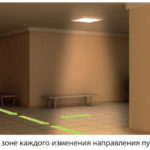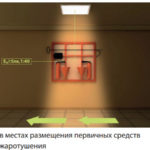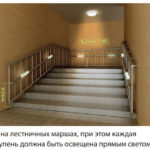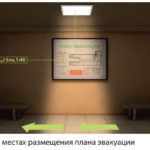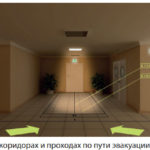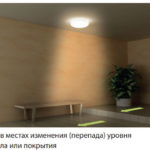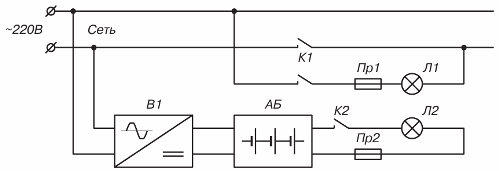Emergency lighting is a mandatory safety measure for crowded places, recommended in private homes and apartments. The sudden onset of darkness causes crowd panic, makes directional movement difficult, and increases the likelihood of injury. Limited visibility interferes with the functioning of schools, kindergartens, museums, cafes, restaurants, etc. The shutdown of the main lighting is the result of equipment failure, electrical wiring, fire, weather conditions: thunderstorms and strong winds. Emergency equipment comes into operation after the main light sources are de-energized. Its purpose is to prevent the negative consequences of a drop in visibility. The rules and regulations for the organization of emergency lighting are regulated by the national standard GOST R 55842–2013. The document is drawn up in accordance with the worldwide ISO 300061: 2007 "Emergency lighting".
Types of emergency lighting
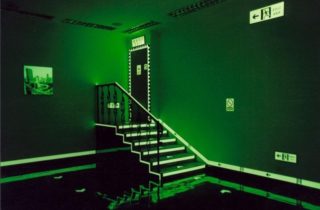
By purpose, there are 2 types of emergency lighting.Reserve JSC ensures the continuity of the working process during power outages. It fulfills 30+% of the working illumination of the space.
Finding a way out of a potentially dangerous room helps a person evacuation lighting. It is classified as follows:
- Anti-panic is installed in spaces of 60 m2 or more, so that people can see each other and obstacles in front of them (including at a height of up to 2 m above the floor). Intensity 0.5 lx.
- Escape route lighting - visibility when moving to the exit from a building or to a safe place, the ability to find fire extinguishers, respirators and other safety equipment. The duration of the action is not less than 1 hour, the intensity is 0.5 lx (1 lx along the axis of the passage).
- In hazardous areas, the standardized lighting should remain at 100% and be interrupted for a maximum of 0.5 s in order to stop work potentially dangerous to health and life of a person properly. Intensity 15 lx.
Locations of emergency network elements
In extreme conditions, the following must be illuminated:
- primary fire extinguishing equipment;
- evacuation plans;
- fire exits, passages and corridors on the way to them;
- each flight of stairs (especially the extreme steps);
- floor level drops;
- crossing and changing the direction of the aisles;
- points of medical aid, emergency communication;
- outside - the final exits.
Inconsistency in the placement of evacuation schemes and fire extinguishers at the design stage of the wiring will entail subsequent problems with the finishing of the walls for finishing.
For some locations, separate standards for emergency lighting have been taken into account. GOST R 53780–2010 informs that elevator cabins must be equipped with a luminaire with a minimum power of 1 W. Visibility is maintained for an hour after the voltage disappears.
GOST R 50571.28-2006 and SP 31-110-2003 are useful in planning emergency lighting in medical institutions. In rooms where procedures are carried out vital for the patient (including intracardiac), 50% of the lamps are connected to the emergency line. In other areas intended for emergency measures and manipulations, there must be at least 1 emergency lamp.
Choice of fixtures and occasions
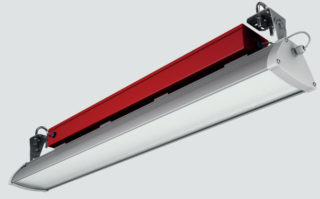
SNiP 23-05-95 (SP 52.13330.2016 "Natural and artificial lighting") provides general rules for the equipment of lighting systems, glare, pulsation. When choosing illuminators, you should check the markings for the nominal voltage, operating mode, requirements for replacing lamps and batteries. The parameters of electrical consumers must comply with the fire safety rules NPB 249 - 97, the requirements of GOST IEC 60598-2-22-2012.
For emergency lighting, LED, fluorescent and incandescent lamps are more suitable. Discharge does not always succeed in providing ignition and re-ignition without delay. No starters are used in the chain. The normalized illumination should be resumed quickly: 50% after 5 s, 100% - 10 s.
There are different requirements depending on the type of luminaire.
- When powered from a centralized backup source (uninterruptible power supply, gasoline or diesel generator), general rules can be followed.
- Autonomous devices (all elements are within 50 cm: lamp, battery, control unit) are accompanied by instructions on the time of continuous operation (1 h, 3 h), date of manufacture, and the service life of the power supply (from 4 years).
- In combination versions, the operating and emergency power wiring must be separated by reinforced double insulation or an earthed shield. The presence of an indicator is mandatory, which indicates the power mode.
Requires fixed or remote network switching control for standby devices.

The built-in batteries are reversible-polarity-protected nickel-cadmium or lead-acid batteries. The voltage inside is respectively 0.8 V and 1.6-1.7 V. They are sealed (electrolyte replacement is not possible) or have a valve. The latter are not suitable for installing the luminaire in any position, and must be specially designed for emergency operation. Batteries wear out quickly, the replacement period depends on the operating time stated in the marking.
SP 6.13130.2009 indicates that the cable for AO must be fire resistant and emit a small amount of halogens and combustion products. These properties are typical for wires marked -ng-LSFR or -ng-HFFR.
Directional signs
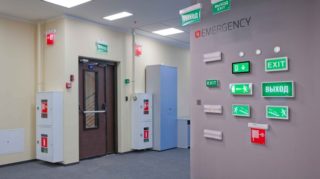
During the evacuation, be sure to follow the special signs. Their location is determined by the GOST R 12.4.026 standard. Safety signs are installed in public and auxiliary premises if more than 50 people can be there at the same time. If the lighting is artificial - more than 30 people. The measure is mandatory for areas over 100 m2. In educational, children's, preschool, medical institutions, places of permanent residence of low-mobility groups, signs are installed regardless of the number of people at the same time. It is allowed to equip light railings in such rooms.
The brightness of evacuation signs on any part of the surface must be at least 2 cd / m2. At the same time, the distribution of illumination along the edges is no more than 5 times less than in the center (10 for plates with a brightness of 100 cd / m2). In case of smoke, the minimum value is 10 cd / m2.
The best option is the design of LED indicators with contours due to the ability of LED strips to consume little energy and glow in different colors.
Evacuation lights complement safety lighting in industrial and public buildings without access to natural light, if the space can accommodate 20 or more people at the same time. Equipment in rooms with a constant flow of people operates from the main electrical system under normal conditions. The safety generator or battery must not be used in operating mode.Photoluminescent plates, which do not belong to the AO system, are used as illumination of the indicators.
Tests for checking the mains
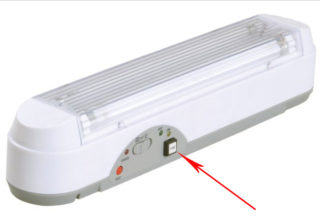
Emergency lighting is not considered functional if it has not been tested after installation. This is especially true for homemade homemade networks. In operating conditions, verification is carried out by visual inspection or by imitation of a malfunction.
Local monitoring involves testing each element separately through the manual test button. In addition, the stand-alone luminaire can be equipped with an integrated tester or a switching device with a remote test device. The rules for conducting are indicated in the manufacturer's instructions.
The button is mounted on the body of the power receiver, its function is to open the network. According to the reaction of the device, it is possible to estimate how quickly it goes into emergency mode, whether the brightness of the lighting, the level of battery charge changes at all. The method is laborious, it does not provide data on the duration of the glow.
Central monitoring is carried out through an additional data cable by transmitting telemetric information through it. This is possible if the devices have a built-in interface for the data cable.
Central address monitoring is carried out automatically through the central unit. It is possible thanks to the addresses that are assigned to each luminaire or sign. Data transfer is carried out over power lines. Various types of tests are performed at the required frequency. To receive reports from luminaires, the LON, BACnet protocols in the building management system can be used, RS485 - via the Internet.
Safety lighting can serve as an evacuation lighting if it meets the requirements for the latter.
Scheme and installation
Power supplies for work lighting and backup lighting must be independent. They are bred from the substation shield. If there is only one input of the power line into the building, then it is divided at the input switchgear. It is unacceptable to install control devices, use common cabinets and group shields for regular and spare power grids. The norms do not recommend the joint laying of the main power line, security and evacuation wiring in one box, tray or mounting profile, but it is allowed if special measures are taken to protect emergency cables from damage to workers: the presence of partitions, corrugated pipes.
The scheme in which the worker and the joint-stock company use 2 types. Lamps are separate.
L1 - main incandescent lamp, L2 - emergency. K1, K2 - contact relays, V1 - rectifier, Pr1, Pr2 - fuses, AB - storage battery.
Lamp L1 is connected through a closed switch K1 to the network. The AB battery is connected to the B1 rectifier and is constantly in the trickle charge mode. Interruption of power supply to the network — contacts K2 are closed automatically, and constant voltage is supplied to the lamp L2 from the backup battery.
Installation of independent sources assumes 2 power supply lines: to a permanent and a spare illuminator. The main light source can be composed of all types of lamps. For emergency mode, low-power devices are used: LED, halogen and 12 W incandescent lamps.
Emergency lighting scheme. 1 source and all types of lamps.
The circuit is assembled from the main and emergency lamp L1, contact relays K1, K2, rectifier B1, fuse (Pr1), inverter I1, battery AB.
The inverter converts the battery charge into alternating current. An unstable mains voltage passes through the rectifier and inverter, the L1 lamp is powered from the mains. Such inclusion excludes premature burnout of lamps, their blinking.
Circuit breakers can be included in the circuits.
Emergency LED lighting is most relevant and effective due to low power consumption, low brightness, and the possibility of using LEDs of different colors to design evacuation signs. Neglect of the installation rules and timely verification of the viability of the emergency network leads to tragic consequences.

